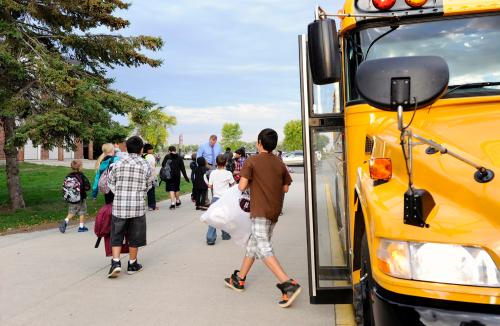Mandatory school busing for racial integration was one of the more controversial policies in American public education. Although busing was necessary for dismantling dual school systems in the south, this unpopular policy drove many middle class and white families away from city school systems, thereby contributing to greater segregation between city and suburban school districts.
Given this history, proposals for new busing plans for economic (and racial) integration may be surprising to some observers, but they continue to crop up in some locales. For example, after being declared unitary more than a decade ago—meaning released from court supervision—Charlotte-Mecklenburg is studying a new student assignment plan to “reduce the number of schools with high concentrations of poor…children.” They have engaged Michael Alves, the architect of “controlled choice,” to design that plan. Controlled choice is a type of mandatory busing that has been very controversial when adopted by larger school districts. As another example, the Minnesota Department of Education recently proposed an administrative rule to expand desegregation to charter schools, and after that proposal was dismissed by an administrative judge, a class action was filed in state court to expand desegregation broadly in the Minneapolis and St. Paul areas.
Given the turbulent history of mandatory desegregation, especially in larger cities, why are some school boards and education agencies still contemplating these policies? The short answer is a continuing belief that the social and educational benefits of desegregation for poor and minority students significantly outweigh its social and educational costs. However, I feel these beliefs in the benefits of desegregation are misplaced and tend to be based on ideological positions, rather than grounded in the evidence. Let’s take a look at some of the costs that tend to get overlooked, and the benefits that tend to be overpromised.
One major piece of evidence that goes ignored is the social cost of mandatory desegregation due to the loss of white and middle class families, the very groups needed in order to have meaningful levels of diversity or desegregation. Clearly, one cannot desegregate these schools without a stable level of white and middle class students with whom they can integrate.
But the historical lessons from desegregation suggest many of these students will flee in the face of mandated integration. For example, after years of desegregation, the Charlotte-Mecklenburg schools (CMS) are only 30 percent white compared to over 60 percent black and Hispanic, most of whom are free lunch students. This compares to a school district that was 71 percent white in 1968, prior to the start of large-scale mandatory busing. Moreover, the largest concentrations of white students live far from the central city where most minority children live. The available non-poor whites could at best desegregate only half of the disadvantaged minority population (at a 50-50 composition). Based on past history, a new mandatory busing plan will lead to further white losses, thus becoming a self-defeating policy.
The other cost is loss of school choice, which is highly valued by most parents, both white and minority. And what parents (of all races) show they value in school choice is situations where their kids are not in the smallest minority of a school. Though middle class parents might be able to continue to exercise choice by relocating when faced with a mandatory school change, most minority parents do not have that financial ability. For example, within the Minneapolis school district there are nearly 50 charter schools, a high choice environment, but their enrollment is predominantly minority. About 30 of these schools are predominantly black or predominantly Hispanic, a few are predominantly Asian, a few are predominantly white, and the rest are more balanced.[1] Since it is unlikely that white students will be attracted to schools that are predominantly black or Hispanic (or vice versa), a policy that applies mandatory racial composition rules to charter schools could mean the closure of these schools and the loss of school choice for thousands of black and Hispanic children and families.
This brings us to the critical issue of educational benefits. One reason that mandatory busing has been a hard sell to middle class white families is that the educational benefits are promised mainly for disadvantaged children. Advocates promise white parents only that their children’s achievement will not be harmed. Of course, there are social benefits for parents who are seeking an integrated environment, but from the research I’ve seen, that benefit is relevant mainly for voluntary plans, since only 20-25 percent of white parents desire a desegregated school that is not their geographically-assigned school. It is not an equitable tradeoff in a mandatory plan where the vast majority of white parents place a high value on their current schools of choice [see here and here].
It might be possible to convince more middle class white parents to participate in a mandatory busing program if the educational benefits for minority children were both substantial and consistent. In my opinion, this is where advocates of mandatory desegregation are most likely to overstate or misrepresent the research.
For example, in the Minnesota hearing on a new desegregation rule covering charter schools, Myron Orfied—a strong proponent of the rule–offered a report prepared by a panel of scholars for the National Academy of Education. Orfield said that the NAE panel “… strongly agreed that the preponderance of the social science evidence strongly indicates positive relationships among school racial diversity [and] academic achievement…”. In fact, the NAE panel offered a far more nuanced conclusion about academic achievement benefits:
“…although the apparent magnitude of the influence is quite variable, there is a relatively common finding that African American student achievement is enhanced by less segregated schooling…. the earliest studies tend to focus on the effects of court ordered desegregation, and therefore, to combine the impacts of racial composition per se with various policy actions undertaken to bring about desegregation. The results of these earlier estimates appear to be more variable than studies focused solely on variations in racial composition.” (page 43) [emphasis added]
I believe the NAE statement is fair summary of the evidence, except most of the earlier studies referenced were not necessarily court ordered, although they were conscious desegregation policies as opposed to demographic variations in school racial composition.
The characterization “quite variable” is not helpful to a school district about to adopt a major desegregation plan, who has to “sell” the plan to parents who may be happy with their current school. It could mean that their desegregation plan might produce significant benefits for some children but not all, or for some schools but not all, or, like many case studies, it could be this plan will not improve achievement for anyone.
Although one more case study will not settle the debate about the effects of desegregation, I will present the results of a new case study[2] relevant to the critical question of whether economic desegregation can raise black achievement and thereby close the achievement gap. This case study uses 2004 and 2005 data to compare black and white achievement in the Charlotte-Mecklenburg district after it had returned to a largely neighborhood school district (in the late 1990s) with black and white achievement in Wake County following implementation of a socioeconomic busing plan in 2000.
Most CMS black students were in majority black schools, while most Wake County black students were in majority white schools. The chart below shows very clearly that Wake County black students did not have higher test scores than CMS students, after adjusting for a student’s socioeconomic background. Moreover, the black-white gap was virtually identical in the two school districts.

From a legal and historical standpoint, it is undeniable that de jure segregation was ended by the Brown decision, but not until several subsequent court decisions that ultimately required the use of mandatory busing did desegregation take full effect in practice. For most of the larger school districts that faced this remedy, there was considerable controversy, and a lot of demographic change as middle class white families left and were not replaced by white families moving to those areas. Some of these demographic changes were due to other forces, but whatever the causes, most urban school systems have substantial de facto segregation, a process aided in part by a return to unitary status by many school districts that had been under court orders.
Many civil rights advocates believe that school segregation is harmful to minority students regardless of the cause, and they continue to propose and support new desegregation plans, especially economic integration since the Supreme Court limited the use race when assigning students to school.
In my opinion, these advocates have not made a sufficient case that more desegregation (either racial or economic) is the best way to improve black or Hispanic achievement, and also that large-scale desegregation is a realistic goal and can be accomplished without the same controversy and resistance that occurred in the 1970s. Indeed, the growth of predominantly minority group charter schools suggests that preference for an “own-group” school is not limited to middle class white parents.
[1] Personal data collected from the NCES Common Core of Data (CCD). Excel file available on request
[2] These results were compiled from North Carolina achievement score database discussed in the essay, David J. Armor and Stephanie Duck, “The Effects of Black Peers on Black Test Scores,” Educational Working Paper Archive, 2007









Commentary
Bringing back busing: Do benefits outweigh cost?
August 23, 2016